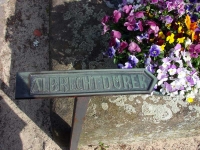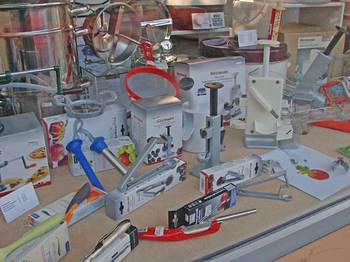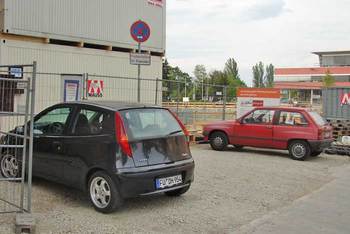St. Albertus Magnus, Stein
Tag Archives: Franconia
Karlsbader Oblaten shop in Nuremberg/Karlsbader-Oblatengeschäft in Nürnberg
I was surprised to see this shop selling Karlsbader Oblaten, cold and warm, in Nuremberg today, though they say they’ve been there for four months.
Here is a machine for making them:
They have a huge range of flavours.
The firm is in Karlsbad – www.kvoplatky.cz
I have often encountered Karlsbader Oblaten – probably on my first trip to Prague in 1966 or my second in spring 1968, and certainly sold from a van in Karlsbad in 1990 or 1991. I have even been to Dillingen, where a former seminary is used for further training for Bavarian schoolteachers, and where the local industries include votive candles and German Karlsbader Oblaten, and visited Wetzel.
There has been a dispute between the Czech Republic and Germany on the use of the name, and I gather that the term Karlsbader Oblaten will be restricted in Germany, but firms like Wetzel which have registered it as a trademark can go on using it.
The statements of objection were declared admissible on the ground, inter alia, that registration of the proposed name would jeopardise the existence of a partly identical name, namely “Karlsbader Oblaten”, in so far that this name is used for a product and not protected under trade mark legislation. The evidence further shows that the name “Karlsbader Oblaten” originated from producers in the town formerly known as Karlsbad and that production of the wafer so named has continued for a considerable period of time. Moreover, the evidence shows that the uses of the name “Karlsbader Oblaten” referred to an authentic and traditional product having a common origin with “Karlovarské oplatky”, but was generally not meant to exploit the reputation of the latter name. For these reasons, and in the interests of fairness and traditional usage, the maximum transitional period foreseen by Article 13(3) of Regulation (EC) No 510/2006 should be foreseen.
I have only tried a small wafer with Nugat (gianduja) cream and it was better than Wetzel’s, I thought.
Pencils/Bleistifte

This is a view of the Faber Castell pencil factory, or part of it, at Stein. I go through Stein most Fridays so this time I got out to take a picture.
The occasion for the picture is an article in the Economist in September, Faber-Castell:
The future of the pencil – An eight-generation family firm shows how innovation need never stop.
Apparently it was Faber Castell that invented the hexagonal pencil, which won’t roll off the table, and various other things.
I got this from IPKAT, where Neil Wilkof is disturbed by the Economist’s claim that Faber Castell stole the idea of putting a rubber (that’s an eraser, for US readers) on a pencil (someone else had patented the idea, but the judge thought it was obvious).
What did The Economist mean by “stolen”? I mean, in today’s world, the bad guys, at least under one view of things, are the patent trolls, who are accused of seeking to enforce a patent solely for the purposed of extracting “unfair” rents from unsuspecting users of the patented invention. No one would go so far as to say that patent trolls are “stealing” from the third parties who agree to pay the troll a sum to settle. Be that as it may, the pejorative context of the patent troll is exactly the opposite from the Faber situation in the 1870’s. All that Faber apparently did was defend itself from an infringement claim by alleging that the patent was invalid. If that is theft, then virtually every defendant in a patent litigation action is candidate to be of a “thief”, if it succeeds in invalidating the patent at issue.
Meanwhile, for those who read German, have a look at Lexikaliker’s blog, mainly about pencils. Even if you don’t speak German, the photos are interesting.

Albrecht Dürer’s grave/Johannesfriedhof Nürnberg
The first time I came here, it was winter.
Now at last I have worked out how to tell where the famous tombs are:
Fortunately Google books helps decipher this (translation from Albrecht Dürer. A Guide to Research, by Jane Campbell Hutchison:
Hier ruhe Künstlerfürst
Du mehr als grosser Mann!
In Vielkunst hat es dir
noch keiner gleich getan.
Die Erd war ausgemalt
der Himmel dich jetzt hat;
du malest heilig nun
dort an der Gottestatt
Die Bau- Bild- und Malerkunst
Die nennen dich Patron
und setzen dir nun auf
im Tod die Lorbeerkron.
Rest here, oh artist prince
Thou more than worthy man!
In mastering all arts
None equalled thee.
Thy work on earth complete
In heaven is thy home;
Thou paintest, saintly now,
Beside God’s sacred throne,
The builders, sculptors, painters
Call thee Patron (saint)
In death they now award thee
The (artist’s) laurel crown.
Vixit Germaniae suae Decus
ALBERTUS DURERUS
Artium Lumen, Sol Artificium
Urbis Patr. Nor. Ornamentum
Pictor, Chalcographus, Sculptor
Sine Exemplo, quia Omniscius
Dignus Inventus Exteris,
Quem imitandum censerent.
Magnes Magnatum, Cos ingeniorum
Post Sesqui Seculi Requiem
Qui Parem non habuit
Solus Heic cubae jubetur
Tu flores sparge Viator.
A.R.S. MDCLXXXI
J. De S.
The glory of Germany is dead.
ALBERTUS DURERUS
Light of the arts, Sun of the artists
Ornament of Noris, his native twn,
Painter, Graphic artist, Sculptor
Without precedent because ominiscient,
Found worthy by foreigners who
Recommend to imitate him.
Magnet of Magnates, grindstone for talents,
After one hundred fifty years
No one having been equal to him
He must repose here alone.
Traveller, strew flowers.
In the year of Salvation 1681
J.D.S.
I didn’t strew any flowers because there were more than enough there anyway.
Here’s the text of this one, in case anyone is searching for it:
Resurgam
Ann Mary
Wife of Edward Dunscomb,
New York
Republic United States N.A.
12. Nov. 1842
16. Mar. 1851. Nürnberg Bayern.
Apalachicola Ann Mary Seon
Daughter Edward,
and Ann Mary Dunscomb
12. Apr. 1842. Brooklyn New York
20 Mar. 184. Halle an der Saale Preussen
Lucas 18, 16 (‘Let the litte children come to me’)
Waiting to be peeled/Wartet auf den Schäler
Brot Schwarz Nürnberg
One wonders why the Germans integrate paper labels in their bread, but when trying to distinguish several dozen types, it’s quite useful.
Feinkost Nikolaus Schwarz, Winklerstraße, Nürnberg.
Nuremberg Zoo/Tiergarten Nürnberg
It’s just been announced that the polar bear cub Flocke will be on public view from April 9. Here is a guide for visitors – after all, the school Easter holidays end next Friday, so from March 31 there will be a few days to visit the Zoo while it’s still civilized.
I can’t get the hang of Google Maps, but if you scroll to the right here you will eventually see the zoo, marked with a blue line.
It is embedded in deep forest, on a hilly and wooded site, and you can see the sandstone where the stone for Nuremberg Castle was quarried. So it’s quite a large and civilized zoo for the visitor – less so for some of the animals. A bit like a mixture between a more generously planned zoo and a crowded inner-city zoo. It would still be in Dutzendteich if Hitler hadn’t wanted that area for a parade ground. And look what happened to that.
Parking is difficult except on the civilized days I just mentioned. So do yourself a favour and get the tram from the main railway station. At the moment, it normally runs every ten minutes and takes fifteen minutes to get there, and you get out closer to the zoo than if you had to park some distance away.
See more in the continuation.
Cherry stoners / Kirschenentkerner
Lawyers / Dres.
In Erlangen:
The famous parking spaces of Dr. Foerster und Partner in Fürth (great photos of staff). These blocked the building of Saturn (electronics store) until it changed the plans:


















